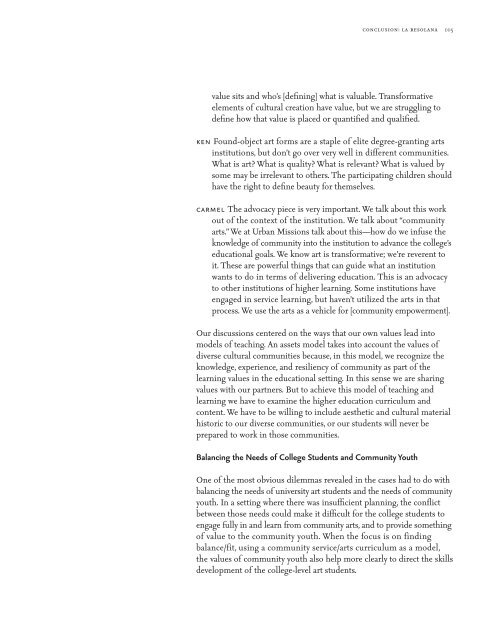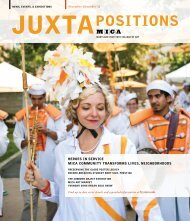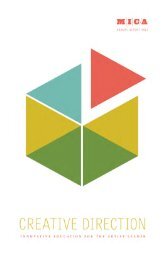art/vision/voice - Maryland Institute College of Art
art/vision/voice - Maryland Institute College of Art
art/vision/voice - Maryland Institute College of Art
Create successful ePaper yourself
Turn your PDF publications into a flip-book with our unique Google optimized e-Paper software.
conclusion: la resolana 105<br />
value sits and who’s [defining] what is valuable. Transformative<br />
elements <strong>of</strong> cultural creation have value, but we are struggling to<br />
define how that value is placed or quantified and qualified.<br />
ken Found-object <strong>art</strong> forms are a staple <strong>of</strong> elite degree-granting <strong>art</strong>s<br />
institutions, but don’t go over very well in different communities.<br />
What is <strong>art</strong>? What is quality? What is relevant? What is valued by<br />
some may be irrelevant to others. The p<strong>art</strong>icipating children should<br />
have the right to define beauty for themselves.<br />
carmel The advocacy piece is very important. We talk about this work<br />
out <strong>of</strong> the context <strong>of</strong> the institution. We talk about “community<br />
<strong>art</strong>s.” We at Urban Missions talk about this—how do we infuse the<br />
knowledge <strong>of</strong> community into the institution to advance the college’s<br />
educational goals. We know <strong>art</strong> is transformative; we’re reverent to<br />
it. These are powerful things that can guide what an institution<br />
wants to do in terms <strong>of</strong> delivering education. This is an advocacy<br />
to other institutions <strong>of</strong> higher learning. Some institutions have<br />
engaged in service learning, but haven’t utilized the <strong>art</strong>s in that<br />
process. We use the <strong>art</strong>s as a vehicle for [community empowerment].<br />
Our discussions centered on the ways that our own values lead into<br />
models <strong>of</strong> teaching. An assets model takes into account the values <strong>of</strong><br />
diverse cultural communities because, in this model, we recognize the<br />
knowledge, experience, and resiliency <strong>of</strong> community as p<strong>art</strong> <strong>of</strong> the<br />
learning values in the educational setting. In this sense we are sharing<br />
values with our p<strong>art</strong>ners. But to achieve this model <strong>of</strong> teaching and<br />
learning we have to examine the higher education curriculum and<br />
content. We have to be willing to include aesthetic and cultural material<br />
historic to our diverse communities, or our students will never be<br />
prepared to work in those communities.<br />
Balancing the Needs <strong>of</strong> <strong>College</strong> Students and Community Youth<br />
One <strong>of</strong> the most obvious dilemmas revealed in the cases had to do with<br />
balancing the needs <strong>of</strong> university <strong>art</strong> students and the needs <strong>of</strong> community<br />
youth. In a setting where there was insufficient planning, the conflict<br />
between those needs could make it difficult for the college students to<br />
engage fully in and learn from community <strong>art</strong>s, and to provide something<br />
<strong>of</strong> value to the community youth. When the focus is on finding<br />
balance/fit, using a community service/<strong>art</strong>s curriculum as a model,<br />
the values <strong>of</strong> community youth also help more clearly to direct the skills<br />
development <strong>of</strong> the college-level <strong>art</strong> students.
















